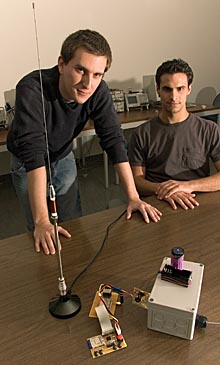David Munday and Matthew Minolli could have graduated last June with degrees in computer engineering. Instead, they got so wrapped up in their senior design project they decided to stay at UCSC for a fifth year as undergraduates so they could see the project through to completion. By the end of this year, they hope to have their wireless sensor network deployed in Yellowstone National Park by the scientists who track one of the world's largest active volcanic systems.
Munday and Minolli led a team of six other students that won top honors in the Baskin School of Engineering's first Senior Design Project Contest in June 2006. Like many senior projects tackled by UCSC engineering students, theirs was proposed by an outside group that had a real-world problem in need of an engineering solution. In this case, the proposal came from Jacob Lowenstern, a research geologist for the U.S. Geological Survey (USGS) in Menlo Park, who oversees the Yellowstone Volcano Observatory.
Yellowstone's world-famous geysers, hot springs, and other hydrothermal (hot water) features are fueled by heat released from a huge underground reservoir of molten rock. The observatory, created in 2001 by the USGS, Yellowstone National Park, and the University of Utah, tracks activity that could lead to hazardous seismic, hydrothermal, or volcanic events in the region.
Temperature measurements are an important part of the overall monitoring effort, but the observatory needs a more reliable and efficient system for gathering temperature data, Lowenstern says.
"Right now we use data loggers that sit there and gather data for weeks or months, and then someone has to go out into the field, download the data, and transfer it to a computer. Sometimes the instruments break, and they might even break a week into their deployment, in which case we wouldn't know until two months later when we go back and find we don't have any data," he says.
His challenge to the UCSC students was to come up with a wireless system that could monitor hundreds of sites throughout the park and feed temperature data back to a central computer at park headquarters.
Katia Obraczka, associate professor of computer engineering, advised the group of eight students who tackled the project. They also had help from several other faculty, including lecturer Stephen Petersen and associate professor of computer engineering Roberto Manduchi.
After brainstorming and coming up with a plan, the students organized themselves into two groups: Minolli led a group working on the wireless communication system, while Munday's group focused on the digital controller for handling data from the temperature sensors. The other UCSC students involved in the project were Tim Jones, Khi Lam, Paul Schooss, Tony Hutter, Jason Rhodewalt, and Yiping Chen.
Their system, designed to send temperature data back to the base station once a day, also allows scientists to log on via the Internet and ask for data from any site at any time. The system also informs researchers of any problems that crop up in the field units. But what makes the system unique is its ability to operate within the constraints of the national park setting.
"Yellowstone is under a lot of pressure to minimize environmental and aesthetic impacts, so relay stations, solar panels, and big antennas are really frowned upon," Lowenstern said.
The monitoring units in the field had to be unobtrusive and use very little power to prolong battery life, while providing long-range radio transmissions. The units also had to operate over a temperature range from boiling hot to well below freezing. And, of course, the system couldn't be too costly.
"A lot of effort went into micromanaging the system so it would use as little power as possible and still meet the specifications," Minolli says.
The system uses a sophisticated networking protocol, thanks to Obraczka's expertise in wireless networking. Transmissions from a unit that is out of range of the base station can be relayed by other units. The base station monitors battery power in all the units and dynamically reconfigures the network to minimize the load on units that are low on power.
"In June, we had the digital controller finished but we were still working on the long-range radio module, so we used an off-the-shelf radio system that had shorter range but allowed us to demonstrate the networking protocol and show that it works," Munday says.
Lowenstern was sufficiently impressed to provide additional funding so the students could continue their work. Three students--Munday, Minolli, and Rhodewalt--worked on the project over the summer under a USGS contract. Minolli and Munday are now continuing their work as an independent-study project.
"I not only felt that we had a responsibility to see this through, but I also really liked doing it," Minolli said. "I plan to study wireless communications in graduate school, and I figured the best way to prepare is to keep working on this project."
"I've been impressed by how dedicated these students are at trying to come up with something that meets our needs," Lowenstern says. "They faced significant technical obstacles that they've been working through with a lot of enthusiasm."
Yellowstone National Park will ultimately decide whether the students' system gets deployed. But Lowenstern says the park geologist has been very enthusiastic about the project, which bodes well for its being accepted by the park.
And if that falls through for some reason, Munday says the design is flexible enough for use in a wide range of other applications.
"We've already had inquiries from other potential clients," he says. "It's a unique and versatile system that you can connect to any kind of sensor and could use in a variety of industries."
___________________________________________________________________________
This article first appeared in the Spring 2007 issue of the UCSC Review magazine.









